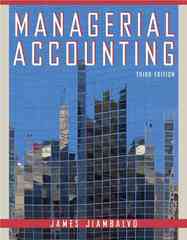Question
Consider a government training program that provides low-skilled men job-specic training. To evaluate this program, members of the target population were randomly assigned to either
Consider a government training program that provides low-skilled men job-specic training. To evaluate this program, members of the target population were randomly assigned to either a treatment group that was eligible to receive services under the program or to a control group that was not. Using this evaluation design, the following information was obtained:
Members of the treatment group were found to remain in the program an average of one year, during which time they received no earnings but were paid a tax-free stipend of $5,000 by the program to help them cover their living expenses. During the program year, the average annual earnings of members of the control group were $20,000, on which they paid taxes of $2,000. During the program year, the welfare and unemployment compensation benets received by the two groups were virtually identical. Program operating costs (not counting the stipend) and the cost of services provided by the program were $2,000 per trainee. During the two years after leaving the program, the average annual earnings of members of the treatment group were $30,000, on which they paid taxes of $3,000. During the same period, the average annual earnings of members of the control group were $25,000, on which they paid taxes of $2,500. During the two years after leaving the program, the average annual welfare payments and unemployment compensation benets received by members of the treatment group were $250. During the same period, the average annual welfare payments and unemployment compensation benets received by members of the control group were $1,500.
(a) (10 pts) Using a 5 percent discount rate, a zero decay rate, and a ve-year time horizon, compute the present value of the net gain (or loss) from the program from the trainee, nonparticipant, and social perspectives. In doing this, ignore program impacts on leisure and assume that all benets and costs accrue at the end of the year in which they occur.
(b) (10 pts) Once again ignoring program impacts on leisure, recompute the present value of the net gain (or loss) from the program from the trainee, nonparticipant, and social perspectives, assuming that at the end of the two-year follow-up period program impacts on earnings and transfer payments begin to decay at the rate of 10 percent each year.
Step by Step Solution
There are 3 Steps involved in it
Step: 1

Get Instant Access to Expert-Tailored Solutions
See step-by-step solutions with expert insights and AI powered tools for academic success
Step: 2

Step: 3

Ace Your Homework with AI
Get the answers you need in no time with our AI-driven, step-by-step assistance
Get Started


